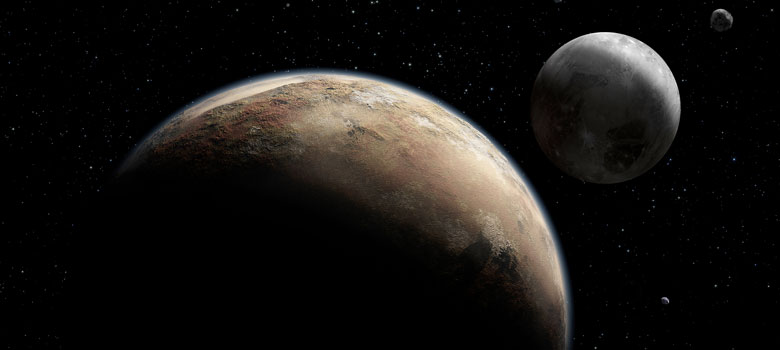FAU to Host 'PlutoPalooza'
Florida Atlantic University’s Astronomical Observatory, Department of Geosciences, as well as the University Libraries will host “PlutoPalooza,” a free, open house event that will showcase various aspects of the science involved with NASA’s historic mission.

Credit: NASA/Johns Hopkins University Applied Physics Laboratory/Southwest Research Institute - Artist's Concept: The Pluto System.
NASA’s New Horizons space probe will fly through the Pluto planetary system on Tuesday, July 14, and at the closest point will be 12,390 kilometers (7,700 miles) from Pluto’s surface. To commemorate this historic event, Florida Atlantic University’s Astronomical Observatory, Department of Geosciences, as well as the University Libraries will host “PlutoPalooza,” a free, open house event that will showcase various aspects of the science involved with NASA’s historic mission.
The open house will take place on Tuesday, July 14 from noon to 9 p.m., and Wednesday, July 15 from noon to 6 p.m., at FAU’s Astronomical Observatory in room 434 of the Science and Engineering building (SE-43), 777 Glades Road, Boca Raton campus. Complimentary parking is available in lots 4 and 7, as well as Garage 3, however, complimentary one-day parking passes must be obtained from the FAU Information Booth at the campus’ Glades Road main entrance.
Pluto’s planetary system is a whole new class of planet. Scientists believe its geology may be made of minerals from Earth-like gases – such as nitrogen, ammonia, and methane – and it will be the first Kuiper belt object ever to be observed from Earth. It also will be the last exploration mission to observe a new planetary system.
Participants of “PlutoPalooza” at FAU will learn about different topics regarding the mission and the Pluto system, including:
- The “Pluto” station will monitor the mission’s progress at FAU’s Observatory.
- The “Charon” station will investigate/discuss the Pluto and Charon’s inferred compositions, compositional/density differences, a “shared atmosphere,” and their cryovolcanism possibilities at the mineralogy laboratory.
- The “Kerberos” station will demonstrate how hyperspectroscopy works by analyzing sand that participants can bring in from their own home and then compare with other samples from around the world, all while assisting graduate students’ research.
- The “Nix” station will discuss the geophysics of planet definitions, orbital transfers, measuring planetary masses, and Pluto’s density and composition.
- The “Hydra” station will demonstrate techniques of remote sensing.
- The “Styx” station will provide artistic projects and New Horizons model building.
- The “Jupiter” station located in the Wimberly Library will showcase displays about the mission including a live feed and the latest images.
- The Jaffe Center for Book Arts in the Wimberly Library will have a display of planetary/celestial artists’ books and a print project on the press.
For more information on “PlutoPalooza,” contact Eric Vandernoot at 561-297-STAR (7827) or vandernoot@mail.sci.fau.edu.
-FAU-
Tags: community | students | research | faculty and staff | science